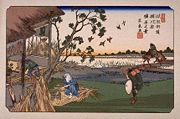
Okegawa-shuku
Encyclopedia

69 Stations of the Nakasendo
The are the rest areas along the Nakasendō, which ran from Nihonbashi in Edo to Sanjō Ōhashi in Kyoto. The route stretched approximately and was an alternate trade route to the Tōkaidō.-Stations of the Nakasendō:...
of the Nakasendō
Nakasendo
The , also called the , was one of the five routes of the Edo period, and one of the two that connected Edo to Kyoto in Japan. There were 69 stations between Edo and Kyoto, crossing through Musashi, Kōzuke, Shinano, Mino and Ōmi provinces...
. It is located in the present-day city of Okegawa
Okegawa, Saitama
is a city located in Saitama, Japan. It was founded on November 3, 1970, and as of 2003, the city has an estimated population of 73,881 and the density of 2,924.82 persons per km²...
, Saitama Prefecture
Saitama Prefecture
is a prefecture of Japan located in the Kantō region of the island of Honshu. The capital is the city of Saitama.This prefecture is part of the Greater Tokyo Area, and most of Saitama's cities can be described as suburbs of Tokyo, to which a large amount of residents commute each day.- History...
, Japan
Japan
Japan is an island nation in East Asia. Located in the Pacific Ocean, it lies to the east of the Sea of Japan, China, North Korea, South Korea and Russia, stretching from the Sea of Okhotsk in the north to the East China Sea and Taiwan in the south...
.
History
At its peak as a post town during the Edo periodEdo period
The , or , is a division of Japanese history which was ruled by the shoguns of the Tokugawa family, running from 1603 to 1868. The political entity of this period was the Tokugawa shogunate....
, there were 36 inns in Okegawa-shuku. Parts of its honjin
Honjin
thumb|250px|The honjin at [[Inaba Kaidō]]'s [[Ōhara-shuku]]. is the Japanese word for an inn for government officials, generally located in post stations during the later part of the Edo period.-Evolution of Honjin:...
remain today. Additionally, the Takemura Ryokan, which operated during the Edo period, is still open for business today, keeping the same atmosphere of its past. On November 13, 1861, Princess Chikako
Kazu-no-Miya Chikako
was the wife of 14th shogun Tokugawa Iemochi. She was renamed Lady Seikan'in no miya after she took the tonsure as a widow.She was the eighth and youngest daughter of Emperor Ninkō and his concubine, Hashimoto Tsuneko - renamed Kangyouin after she took the tonsure. She was the younger half-sister...
stayed here.
The city of Okegawa now runs the Nakasendō Shukuba-kan, which provides information on the old post town, as well as walking maps. Including in the walking courses are its honjin and one of its hatago
Hatago
were Edo period lodgings for travelers at shukuba along the national highways, including the Edo Five Routes and the subroutes. In addition to a place to rest, hatago also offered meals and other foods to the travelers...
.

